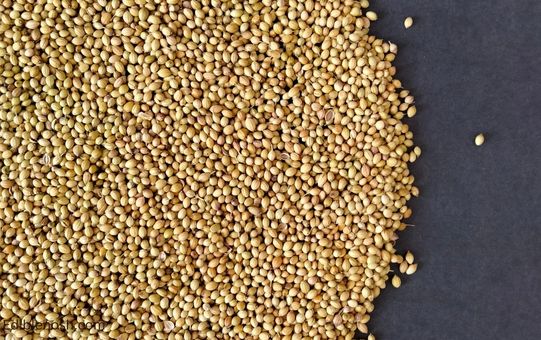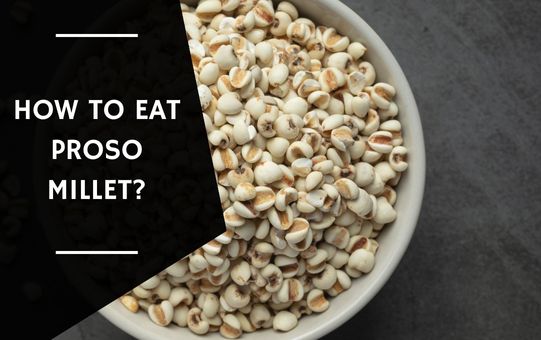The Proso Millet is one of my favorites. It has the consistency of couscous and a milder flavor. But what is the precise method and How to Eat Proso Millet? This is a question posed by many individuals.
For a nutritious and delicious meal option, cook proso millet like rice, add it to salads, make porridge, incorporate it into pilafs, and stuff it into vegetables.
In this article, we will discuss the fundamentals of proso millet, including how to prepare and enjoy it.
Contents
Why Eat Proso Millet Matter?
Proso millet is a nutritious and adaptable grain that provides numerous health benefits. It is rich in protein and fiber, which can help you feel satisfied for longer.
In addition, it is an excellent source of essential minerals such as iron, potassium, and magnesium, which are crucial for maintaining healthy bones, muscles, and blood pressure. Additionally, proso millet is gluten-free, making it an excellent option for individuals with gluten sensitivities. In addition, it is an excellent source of antioxidants, Vitamin B6, and Folate.
Additionally, proso millet has a low glycemic index, which means it releases sugar slowly into the bloodstream and can help regulate blood sugar levels, making it an excellent option for diabetics.
Also, the antioxidant and anti-inflammatory properties of proso millet have been linked to a reduced risk of cardiovascular disease.

Furthermore, proso millet is a sustainable and environmentally friendly crop, as it requires less water than other grains and can grow in arid and poor soil conditions. This makes it a resource-efficient alternative to more resource-intensive grains.
Read Also: What Is The Importance Of Millet?
What is Proso Millet?
Native to central Asia and eastern Europe, proso millet, also known as common millet, is a type of cereal grain. The grain is similar in size and shape to quinoa and is pale yellow in color.
Proso millet is an excellent source of protein, fiber, and minerals such as potassium and iron. Additionally, it is gluten-free, making it an excellent option for individuals with gluten sensitivities.
How to Cook Proso Millet?
Cooking proso millet is similar to cooking rice, but slightly more water is required. Begin by rinsing the millet in a strainer with a fine mesh to eliminate any dirt or debris. In a medium-sized saucepan, bring 2 cups of water to a boil.
Add 1 cup of millet and stir thoroughly. Cover the pan and simmer on low heat, the average proso millet cooking time for 18 to 20 minutes. After cooking millet, fluff it with a fork and let it rest for a few minutes before serving.
Ways to Enjoy Proso Millet
You can enjoy proso millet in the ways listed below.
As a side dish
Similar to rice, proso millet can be served as a simple side dish. Simply prepare the millet according to the instructions above and season it with salt and pepper. You may also add herbs or spices to enhance the flavor.
In a salad
Additionally, proso millet can be used in salads. Prepare the millet as instructed and allow it to cool. Then, combine it with your preferred salad greens, some vegetables, and a flavorful dressing.
As a breakfast cereal
Additionally, proso millet can be used to make a scrumptious breakfast porridge. Cook the millet in a mixture of milk and water, sweetener, and spices such as cinnamon and nutmeg. Add your favorite fruits and nuts for a nutritious breakfast.
In a pilaf
Additionally, proso millet can be used to create a flavorful pilaf. Following the above preparation instructions, sauté the millet with onions, garlic, and spices such as cumin and coriander. Then, add vegetables and a small amount of broth and cook until everything is hot.
As a stuffing
Proso millet can be used to make a delicious filling for vegetables such as bell peppers, zucchini, and tomatoes. Cook the millet according to the instructions above, then combine it with sautéed vegetables, herbs, and spices. Stuff the mixture into your preferred vegetables, top with cheese, and bake.
Nutritional Benefits of Proso Millet
Proso millet is a grain rich in essential vitamins and minerals. Here is a brief table highlighting some of the most important nutritional advantages of proso millet:
| Nutrient | Amount per 100g |
|---|---|
| Protein | 12g |
| Fiber | 3g |
| Iron | 2mg |
| Potassium | 180mg |
| Magnesium | 60mg |
| Phosphorus | 300mg |
| Zinc | 2.5mg |
As shown, proso millet is an excellent source of protein and fiber, which can help you feel full and satisfied. Minerals such as iron, potassium, and magnesium, which are essential for maintaining healthy bones, muscles, and blood pressure, are also abundant in this food.
Proso millet is gluten-free, making it an excellent option for those with gluten intolerance.
In addition, it is an excellent source of antioxidants, vitamin B6 and folate, all of which are essential for overall health.
Consider proso millet if you’re looking for a nutritious and tasty grain to incorporate into your diet.
Recipes featuring Proso Millet
The following are well-known recipes containing proso millet:
Recipe #1: Proso Millet Pilaf with Vegetable Ingredients:
- 1 cup proso millet
- 2 cups vegetable broth
- 1 tbsp olive oil
- 1 onion, diced
- 2 cloves garlic, minced
- 1 cup diced carrots
- 1 cup diced celery
- 1 cup diced bell pepper
- 1 tsp ground cumin
- 1 tsp ground coriander
- Salt and pepper to taste
- 1/4 cup chopped fresh parsley
Instructions:
- Rinse the proso millet in a fine-mesh strainer and set aside.
- In a large saucepan, heat the olive oil over medium heat. Add the onion and garlic and sauté until softened.
- Add the carrots, celery, and bell pepper and continue to sauté for an additional 5 minutes.
- Stir in the cumin and coriander, and cook for 1-2 minutes more.
- Add the proso millet and vegetable broth to the pan and bring to a boil.
- Reduce the heat to low and cover the pan. Simmer for 18-20 minutes, or until the millet is cooked through and the liquid has been absorbed.
- Remove from heat and fluff with a fork. Stir in the chopped parsley and season with salt and pepper to taste.
- Serve as a side dish or as a main dish with some protein of your choice.
Recipe # 2: Proso Millet Porridge with Berries and Nuts Ingredients:
- 1 cup proso millet
- 2 cups water
- 1 cup of milk of your choice
- 2 tbsp honey
- 1 tsp ground cinnamon
- 1/4 tsp ground nutmeg
- 1 cup mixed berries
- 1/4 cup chopped nuts (almonds, walnuts, pecans)
Instructions:
- Rinse the proso millet in a fine-mesh strainer and set aside.
- In a medium saucepan, bring the water and milk to a boil.
- Stir in the proso millet, honey, cinnamon, and nutmeg.
- Reduce the heat to low and cover the pan. Simmer for 18-20 minutes, or until the millet is cooked through and the liquid has been absorbed.
- Remove from heat and fluff with a fork.
- Serve in bowls, topped with mixed berries and chopped nuts.
These are just a few of the many delicious ways you can enjoy proso millet in your meals. With its nutty flavor and versatility, it’s a great alternative to other grains and can be used in a wide range of dishes. Try incorporating proso millet into your meals and discover new ways to enjoy this healthy and delicious grain.
Read Also: Why Should We Soak Millet Before Cooking?
Tips for Incorporating Proso Millet into your Diet
This is how you can incorporate proso millet into your diet:
- Start with small amounts: If you’re unfamiliar with proso millet, it’s best to start with small amounts and gradually increase them as you become accustomed to the grain’s unique texture and flavor.
- Experiment with different cooking methods: Experiment with various cooking techniques; Proso millet can be prepared in a variety of ways, including boiling, simmering, and baking. Try various cooking techniques to find the one you prefer most.
- Mix it with other grains: Proso millet can be combined with other grains such as quinoa, rice, and barley to add variety to your meals.
- Use it as a replacement for other grains: Proso millet can be used as a substitute for other grains in dishes such as pilafs, salads, and soups.
- Add flavor with herbs and spices: Proso millet has a mild, nutty flavor that pairs well with a wide range of herbs and spices. Try adding some fresh herbs or spices such as cumin or coriander to your proso millet dishes to enhance their flavor.
- Experiment with different toppings: Proso millet can be topped with a variety of items for added texture and flavor, including nuts, seeds, cheese, fruits, and vegetables.
- Mix it with protein: Proso millet can be combined with proteins such as chicken, fish, or tofu to create a complete meal.
- Incorporate it in your breakfast: Proso millet can be made into a delicious breakfast porridge with milk, sweetener, and spices, then topped with fruits and nuts.
By experimenting with various cooking techniques and incorporating proso millet into your meals, you will discover new and delicious ways to enjoy this wholesome grain.
Proso Millet Substitutes
Proso millet is a versatile and nutrient-dense grain, but other grains may be substituted in recipes that call for proso millet. Here are some alternatives to consider:
- Quinoa: Quinoa is a small, round grain that is comparable in size to proso millet. It has a mildly nutty flavor and a slightly chewier texture than proso millet, but it can be utilized in the same manner.
- Buckwheat: Buckwheat is an additional gluten-free grain that can be substituted for proso millet. It has a distinct nutty flavor and a texture that is slightly chewy than proso millet. It can be utilized in numerous dishes, such as porridge, salads, and pancakes.
- Amaranth: Amaranth is an additional ancient grain that can be used in place of proso millet. It has a mildly nutty flavor and a slightly chewier texture than proso millet, but it can be utilized in the same manner.
- Farro: Farro is an ancient wheat grain that is interchangeable with proso millet. It has a nutty taste and a chewy consistency.
- Barley: The versatile grain barley can be substituted for proso millet. It has a nutty flavor and a chewy texture, and it can be used in soups, salads, and porridge, among other dishes.
- Bulgur: Bulgur is an alternative to proso millet that is made from cracked wheat. It can be used in a variety of dishes, including pilafs, salads, and soups, due to its nutty flavor and chewy texture.
Notably, although these grains can be used as substitutes, they may have different cooking times and absorb liquids differently; therefore, it is best to consult a recipe or cooking instructions for specific instructions.
Verdicts
The versatile and nutritious grain proso millet can be used in a variety of dishes. Whether you’re looking for a simple side dish or a more involved recipe, proso millet is an excellent choice. Try it and you will discover how delicious and simple it is to incorporate into your meals.

